We occasionally link to goods offered by vendors to help the reader find relevant products. Some of these may be affiliate based, meaning we earn small commissions (at no additional cost to you) if items are purchased. Here is more about what we do.
Since the microwave became widely available to purchase for everyday residential use in the 1970s, it has changed the way many people prepare and heat food at home – and we love it!
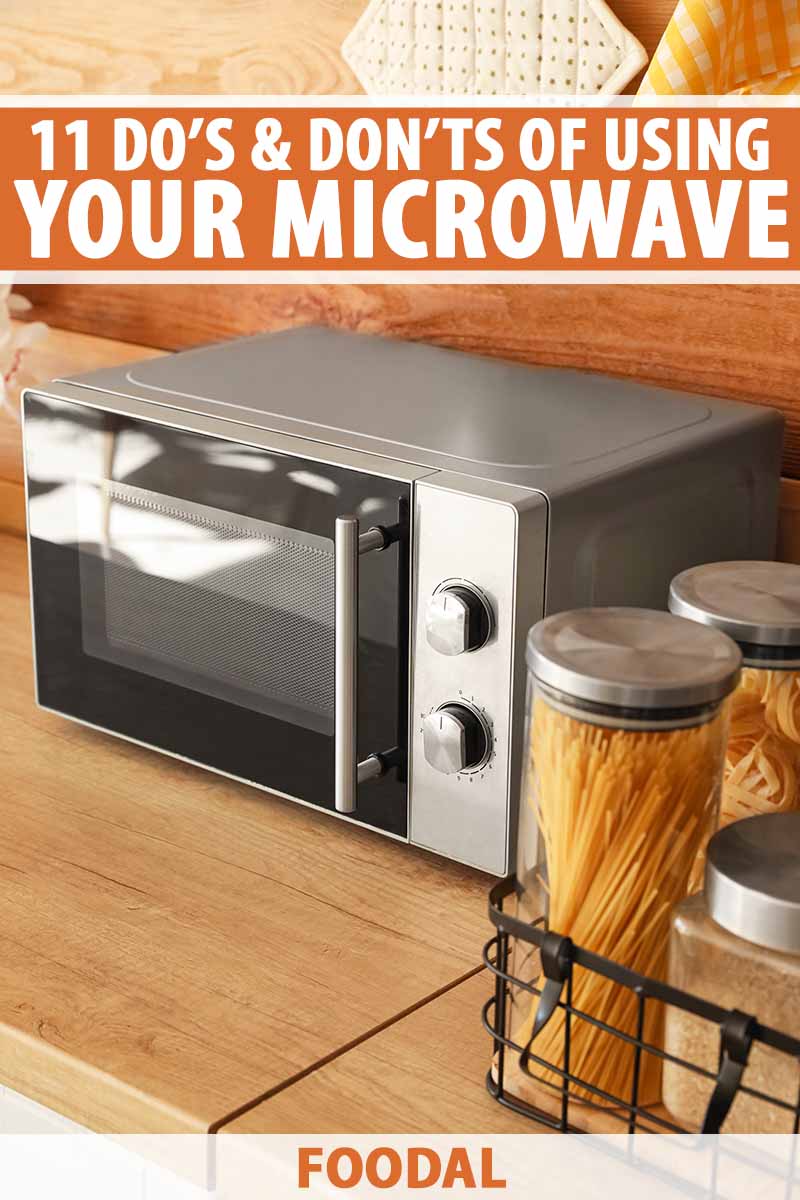
Even though it was originally patented in 1945, it did take a few additional decades to refine its manufacturing for affordable home use, which soon triggered a massive boom in popularity.
As opposed to cooking on a stovetop or in the oven, this device indirectly warms food via microwaves, a form of electromagnetic radiation that is absorbed by the food and generates heat within it.
The result?
Hot food in an impressively short amount of time!
By using a microwave, you can put a warm and steamy meal on the dinner table in a matter of minutes.
Whether heating an individual packet of instant oatmeal, warming leftovers from last night, or quickly melting a stick of cold butter, anyone with a busy schedule and hungry belly will appreciate its assistance.
However, just like with any kitchen appliance, there are certain rules to follow to get the best results using the most effective and safest methods.
Below you’ll discover 11 quick do’s and don’ts of using the microwave, which we suggest you follow closely before you press the “Start” button to make your next meal.
11 Important Do’s and Don’ts of Using the Microwave
The Do’s
Here are some essential pieces of advice that you should follow in order to safely operate your microwave:
1. Do Read and Follow the Owner’s Manual
You may think it’s simple to operate a microwave… and you’re absolutely right!
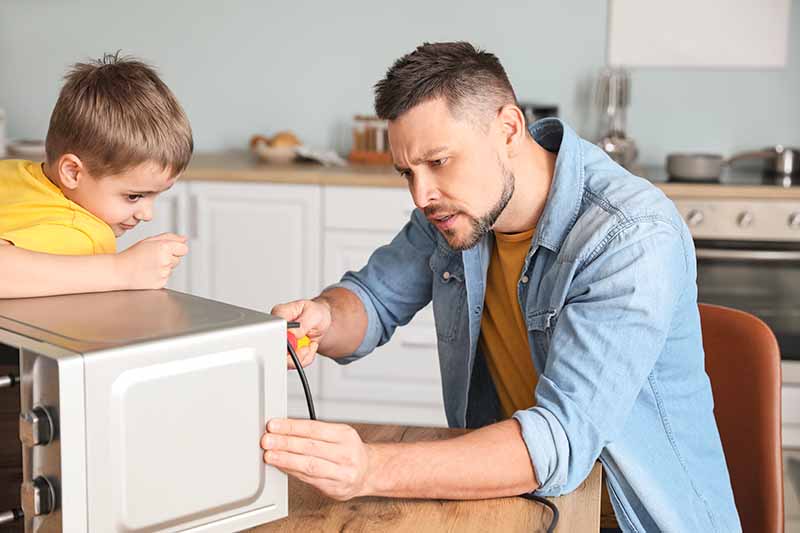
But that still doesn’t mean you should operate it without conducting a brief review of its operational requirements first.
The manual includes a wealth of information you need to know for safe, healthy cooking, including procedures and safety warnings.
Read it carefully, and follow its instructions – every item has unique features, so the make and model of the device you own will have its own requirements that may be different from ones you have used in the past.
And complaining to us that you’ve thrown away the manual long ago is no excuse! Most manuals can be found in an online format on the manufacturer’s website.
2. Do Read and Follow Packaged Food Instructions
I know you’re hungry – you’re starving after a long day at work or running errands, and you cannot wait to heat up that package of spicy ramen or the frozen vegetarian burrito bowl you rushed to pick up from the store on your way home.
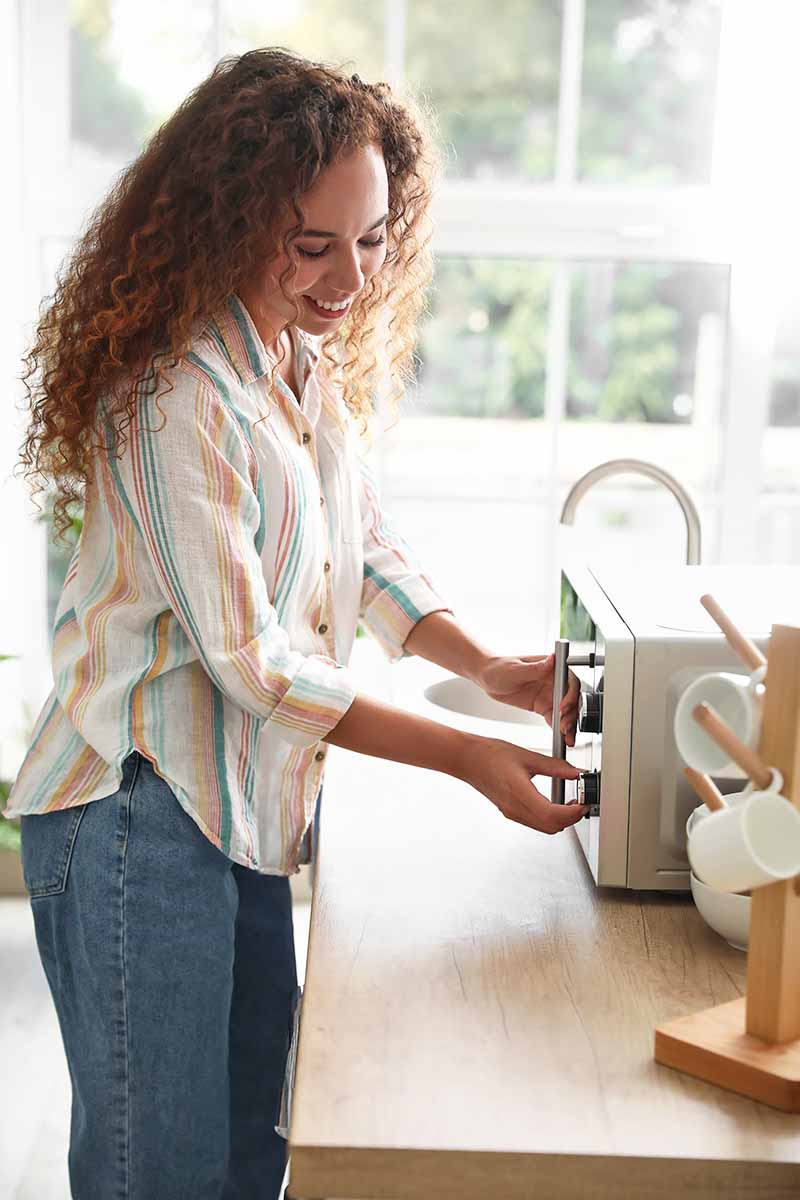
But before you do… carefully read and follow the instructions on any prepackaged foods you’re going to cook or reheat!
The cooking times given are important to follow as a basic guideline to understand how long the microwaving process will take.
Underheating food in your model can leave you with cold, tasteless items that may still contain harmful bacteria that wasn’t destroyed by heating to the appropriate temperature.
On the other hand, overheating food can make it tough, rubbery, and inedible. It can even lead to burnt food, or potentially igniting a fire.
The instructions will also provide you with safe heating instructions – you may be able to heat directly in the packaging, or you may need to transfer the contents to a plate or bowl.
3. Do Use Appropriate Heating Vessels
Make sure you are using microwave-safe containers, plates, or bowls!
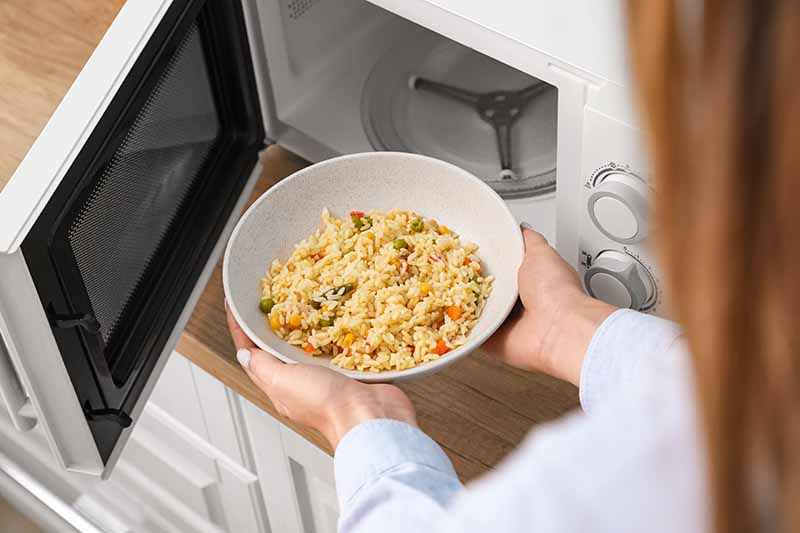
Glass and ceramic dishes are usually safe choices, and there are certain styles of plastic containers that are also microwavable.
But we always recommend checking to make sure.
Suitable dishes are usually marked or stamped on the bottom, often with the phrase “microwave-safe” clearly marked.
For the sake of safety, if you’re not certain whether a bowl, dish, or plate is safe or not, don’t use it!
4. Do Carefully Open Heated Containers
Don’t rush to open a container immediately after microwaving it, especially if the contents are being heated in a bag or box that doesn’t require you to open or vent it first.
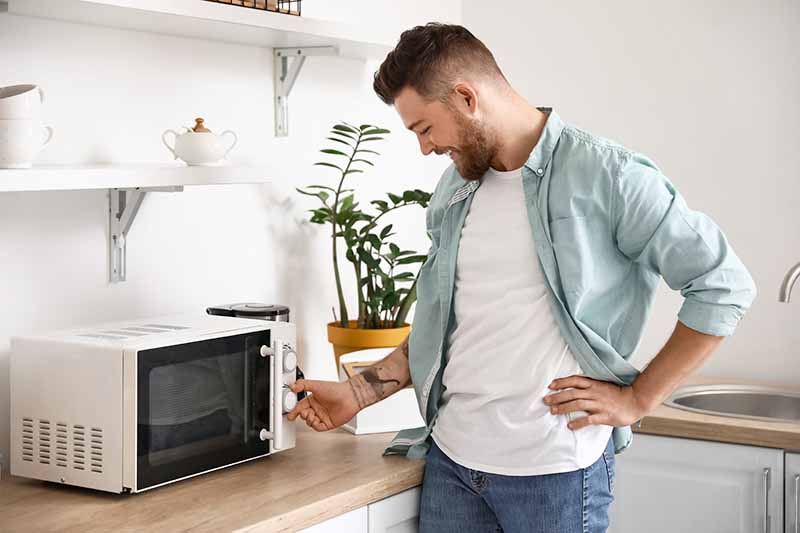
When you heat items in a closed – or even partially closed – container, hot steam will build up inside. The steam may damage your skin if you’re overzealous in your readiness to chow down on your meal! So be sure to use caution in this type of scenario.
Wait for about 30 seconds before opening, and open the container away from your face so you are not in the direct line of the scalding steam escaping.
5. Do Clean, Clean, Clean
There aren’t many things in the kitchen more disgusting and repulsive than a messy, smelly, unkempt equipment that has not been cleaned for months upon months… and perhaps years of extreme neglect…
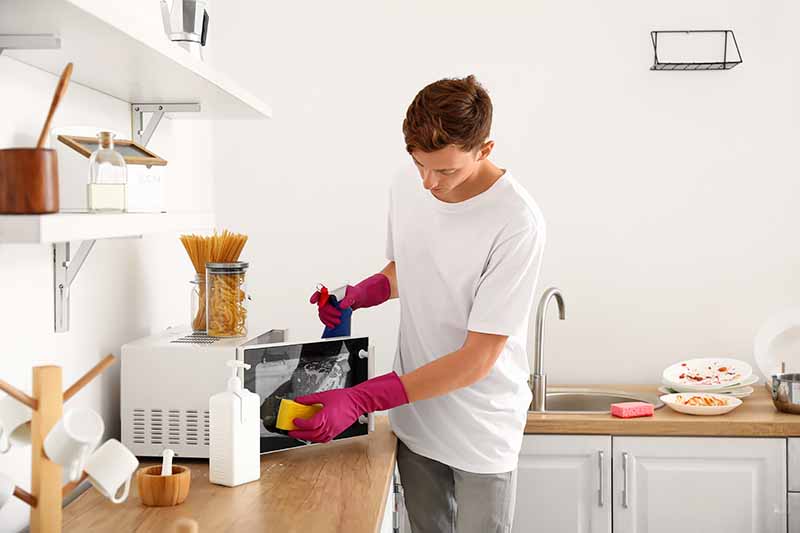
As we discussed in our article on organizing kitchen chaos in 15 minutes at a time, you can easily implement light cleaning tasks into your daily lifestyle at home.
And the microwave should fall within those cleaning responsibilities! Don’t forget about it!
If you’re cleaning regularly as you use it, wiping away a few splatters here and there with a multipurpose cleaning spray and rag, the mess won’t continue to build.
Clean the inside of the door and the interior after every use, or at least every other use. This will prevent food and splatters from becoming cooked onto the surface, making it easier to clean.
The Don’ts
And now, here are the top no-no’s you should not do when operating your appliance, to avoid any hazardous outcomes:
6. Don’t Use Cheap, Disposable Plastic Containers
Any sort of single-use plastic containers or packaging – items like plastic wrappers, salad boxes, certain takeout containers, spreadable butter or margarine tubs, or whipped topping containers, to name a few – will not be safe options for heating in the microwave.
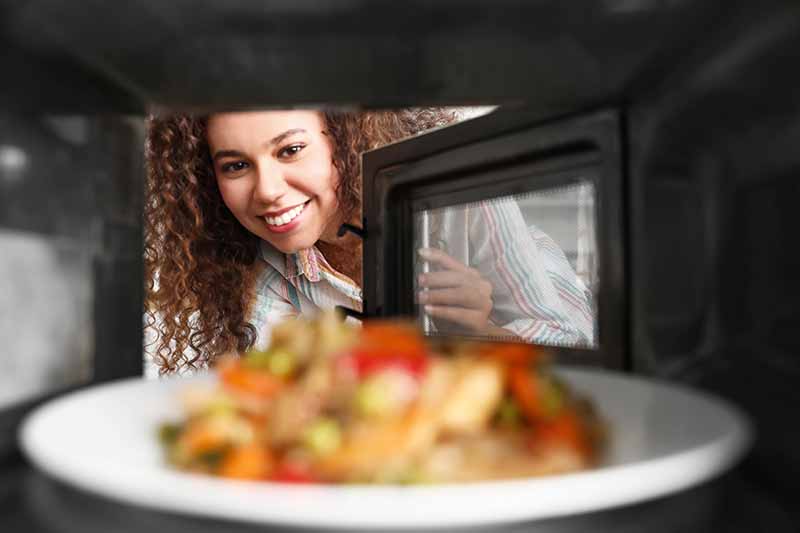
The plastic can melt, and may even contaminate the food or beverage inside with the infusion of harmful chemicals.
Let’s mention this again, as a great reminder – check with the container to determine if it is safe to use in the microwave.
If you have any uncertainty, transfer the food to a plate or bowl that you know will be safe to use.
7. Don’t Microwave Metal Objects
No metal objects! Big red flag! Don’t do it!

Don’t heat any kind of metal object in a microwave, because this can produce dangerous sparks that will lead to dangerous mayhem in the form of smoke, and fire.
This includes aluminum foil, serving and eating utensils, pots, pans, plates, or bowls.
There are a few rogue items that you may not realize contain metal, such as dishes that have a metallic trim on them or the wrappers of certain candy bars.
A past childhood traumatic experience of attempting to warm a frozen Twix bar, still in the aluminum-coated plastic wrapper, will prove how dangerous even something so small and innocent as a mini candy bar could be.
8. Don’t Heat without Covering
There are multiple methods available to cover exposed food when you are using this piece of equipment – an important step to take when reheating leftovers!
Fully covering your food is another action to take to help ensure your appliance’s long-term cleanliness.
It also helps to prevent food from drying out as it heats by retaining some steam.
Tovolo Collapsible Microwave Food Cover, available from Sur La Table
When heated, the water in your food rapidly absorbs the energy from the microwave, raising its temperature more quickly than solids like proteins and carbohydrates in the same food.
This causes some foods with a higher liquid content to splatter allllll over your microwave – unless they are covered properly!
While a damp paper towel spread on top of the exposed surface of your food can do the trick, you should consider purchasing a food cover if you constantly use your appliance.
It’s a tool you can reuse every time you heat something, rather than tossing out and wasting paper towel after paper towel.
The Tovolo Collapsible Microwave Food Cover is a BPA-free silicone gadget that can expand to cover different heights of dishes in your appliance. It also features multiple perforations, allowing some excess steam and moisture to safely escape.
You can buy it now from Sur La Table!
9. Don’t Operate While Empty
According to the FDA’s tips on safe microwave oven operation, you should not operate your appliance if it’s empty.

Running a microwave while it is empty may potentially cause some damage to it.
And the reasoning behind this may be surprising…
Since there is no food or liquid to absorb the energy that’s produced, the magnetron tube that helps to power the appliance to produce the microwaves can be damaged. With no food for the waves to absorb into, the only action available is for them to bounce around in the enclosed appliance.
With some makes and models, if this is done repeatedly for long periods of time, this can potentially result in permanent damage to the equipment. It may also result in a potential implosion and fire.
Another reason to refer back to Rule #1 on our list and closely adhere to the instructions and cautions found in the owner’s manual for your specific model!
10. Don’t Use Faulty Equipment
There are several clear signs that your equipment is faulty, defective, and broken to be on the lookout for:
- The door won’t close properly
- The door is bent or warped
- The latch is broken or faulty
- The electrical plug or cord is frayed
- There is an electrical burning smell while in use or afterwards
These are all cases where you need to immediately stop operating your appliance. Call for professional services or replace the unit if any of these conditions exist.
Before you operate a new appliance, or ideally before you buy, always check to see what the warranty, return, and exchange policies are!
11. Don’t Heat a Bottle Full of Baby Formula
Here is a tip for new parents or parents-to-be that you may not be aware of:
You should not heat a bottle full of baby formula or breast milk in the microwave.
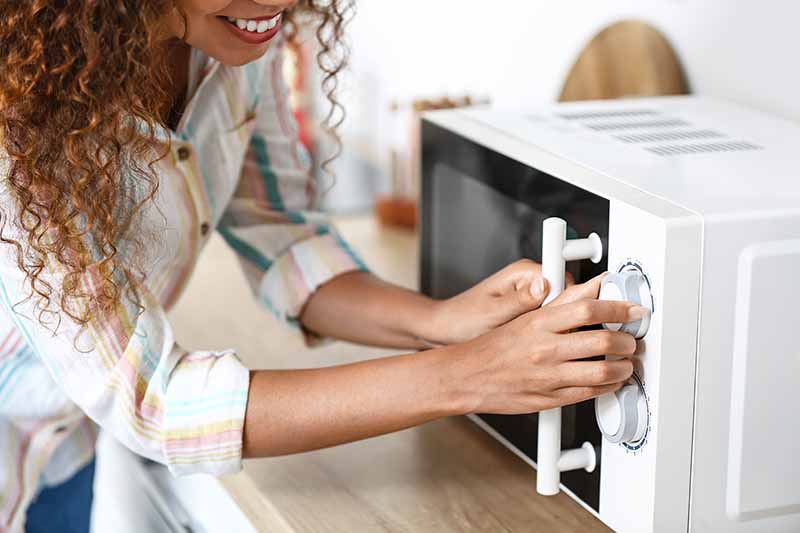
This is due to a serious temperature safety concern – the bottle may feel like it’s the right temperature, but the milk inside may be extremely hot!
Using the microwave may also heat the formula or milk unevenly, resulting in hot spots. The high temperature poses a danger to a newborn baby, as it can potentially scald your infant’s mouth and throat.
Ride the Waves
While many of these 11 rules may be seen as simple and obvious, and you might already be following these recommendations carefully in your own kitchen, it’s always smart to review and discuss the basics!

Whether you use these tips as brief reminders, or if you’re entirely new to the world of microwaves, you now have quick access to the most fundamental operational standards.
The safety of your home and family, the integrity of your food, and the cleanliness of your appliance all depend on a knowledgeable owner and user!
Are there other do’s and don’ts that you would suggest fellow readers follow? Leave a comment with your best advice!
For more helpful tips on how to skillfully use your kitchen gizmos and gadgets, review all of our kitchen gear guides and product reviews. We have three here we think you’ll like to read next:
- Electric vs. Gas Stoves: Which Is Better?
- 17 Practical Tips for Using Your Dishwasher
- How to Use Your Refrigerator’s Crisper Drawers
© Ask the Experts, LLC. ALL RIGHTS RESERVED. See our TOS for more details. Originally published on October 16, 2014. Uncredited photos via Shutterstock. Product photos via Sur La Table. Last updated July 3, 2023.
About Nikki Cervone
Nikki Cervone is an ACS Certified Cheese Professional and cheesemonger living in Pittsburgh. Nikki holds an AAS in baking/pastry from Westmoreland County Community College, a BA in Communications from Duquesne University, and an MLA in Gastronomy from Boston University. When she's not nibbling on her favorite cheeses or testing a batch of cupcakes, Nikki enjoys a healthy dose of yoga, wine, hiking, singing in the shower, and chocolate. Lots of chocolate.

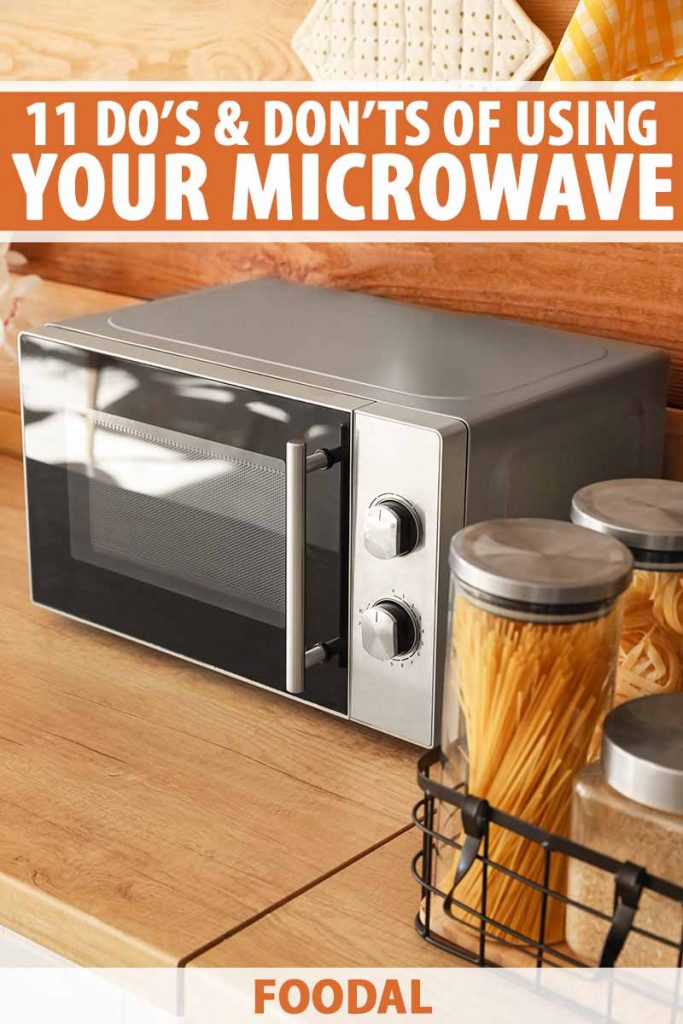
Thanks for all these tips, there’s a fair few which I didn’t know!
A small tip I might add is that when using a microwave to reheat food, place a damp paper towel over the food. The water in the paper is converted into steam, keeping the food from becoming too hard and dry, and also ensuring even reheating.
I use a damp paper towel, too. It makes such a difference when reheating food. You are absolutely right about the even heating of the food. When I don’t use a damp paper towel, some of the food is cold and some of it is too hot.
I also do this, and it makes a world of difference in how your food taste. Not to mention the texture, the drying affect a microwave has on food is very fast. So I totally agree with you. A damp paper towel works wonders when warming food.
Thank you Cheddar for that wonderful tip as well, these tips are awesome, i had a microwave once…became faulty and i became lazy…still on my budget to-do list, glad i had not purchased yet, glad to have stumbled upon these tips, at least now i can buy one with ease 🙂
This technique doesn’t work very well if you are trying to reheat sticky rice. It just makes it drier than it already is.
There should be a universal guide to this as I see so many people not covering their food and leaving splatters everywhere.
I didn’t know about leaving the microwave on if nothing was in there that it could get damaged. I thought it was a waste of power. I’m sure not many people know this fact and pull out food early and then let it run if they are too lazy to hit the end button.
A guide should be put up in work places with microwaves as many people abuse them.
This is a very comprehensive list. It seems like these things should be obvious, but there are people who don’t know these things and it’s always helpful, and safe, to know!
I have never read a microwave manual before. Maybe I will do it next time a buy a new one, it could have some good tips for me. I do clean my microwave, but not after ever use. I usually do it once every few days. I think that this has a lot of good tips. I need to focus on the “don’t” part of the list.
Good tips. A lot of people are so against microwaves but I think they’re alright. Those people are generally not using them correctly. I should refer them to your post! As long as you use it for simple short tasks, all is well.
Thank you for these tips. Even though they sound like very common things people should be doing already, I can tell you I didn’t know more than 80% of this info. I’ve even melted plastic with my food once! I’ll use this helpful guide whenever I try to go near a microwave now.
I did the water test today! I had a few minutes to spare so I did it for ‘fun’. My microwave is actually a higher wattage than I thought! Good to know. I didn’t originally buy it myself so I had just assumed it was a certain wattage…no idea why. Now I know 🙂 Thank you for the tip.
This is what’s making me take time in buying a microwave…high wattage, piling electricity bills…as much as i may want to have it now, i think i’ll put a pause… up until i get some stuff figured out. 😉
As dangerous as microwaves can be one would think they would put the most important warnings somewhere prominent on the thing. I almost burned down the office once when I put a small plastic container in for a few seconds that had a tiny piece of foil still stuck to its edge. Such a little timesaving device can be a big danger.
I am going to spread the word about the water test. That will come in handy. You have no idea when you step in front of one and press the start button what kind of power you are dealing with.
When it comes to microwaves, I just don’t trust them, I had a few bad experiences: a memorable one was when I put an egg to boil and when I took it out and cracked it, it just exploded in the whole kitchen.
Then, you reminded me of baby milk, it’s true, must be very careful! When I was a waitress it happened that moms would ask me to heat up their milk and at the time I already had 2 babies, I would always test the temperature of the milk on my wrist to see that it wasn’t too hot. Must be careful about how to use this device, I always prefer traditional hob.
Steer clear of all microwave popcorn. There have been multiple studies that microwave popcorn can cause lung cancer. There are substances in the bag, especially in the artificial flavoring that releases a toxic gas. The gas gets trapped in the bag, and then released right into your face when you open the bag. It is not that hard to pop popcorn on the stove. It just means you have to wash a dish. I would rather wash dishes than risk cancer.
Wow. I never knew that. That’s kinda scary sounding
A great post with great tips! We can all use these reminders as the convenience of the microwave is something that we take for granted! A lot of people take shortcuts and don’t think about the consequences sometimes.
Ah microwave cooking! Yes reading the instructions carefully can save someone from a great big mess. I remember one time I was in a rush. I forgot to put the lid back on as specifically stated in the instructions. It splattered all over my microwave. While it was still tasty and perfectly edible, I ended up cleaning all that goop.
I cannot even remember *seeing* a microwave’s manual! But these are sound advices. Even “sturdy” plastic can melt over time and makes it less safe for eating from it then. I don’t think I ever owned a microwave that I cleaned regularly. Thankfully they sell those sort of plastic bells that you can put on top of your plate, so there’s that. Just using this limits the messes and splatter, and a quick wash is the simplest thing ever!
Thanks for the reminders!
I was told once that the “Microwave Safe” notation on plastics means that it’s safe for the container – not necessarily safe for people to eat from it. With all the BPA-free plastics available now, I am much more mindful of my plastic use when it comes to foods. I have saved myself the step of checking for microwave safety with plastics by only using glass dishes in the microwave. That might not be for everyone, but I enjoy the peace of mind, while not having to give up my handy, speedy microwave!
Oh my goodness, I think I’ve always been using microwave-safe plastic containers to reheat my lunches. I don’t think I’ve ever looked to see if it was BPA-free. Ahh, maybe I should be carrying glass containers from now on, even though they are incredibly heavy. The weight is only temporary, the damage to myself is permanent 🙁
My BPA fear is so real! I absolutely never use plastic in the microwave and avoid buying food in plastic packaging as much as possible, my husband and I are on fertility treatments so no plastic is imperative!
I also don’t defrost any food in the microwave and I’ve stopped cooking veg in the microwave as well because I cant find a glass/ceramic steamer (does anyone know if you can put a bamboo steamer in the microwave?)
It’s actually remarkable how many things you can make using just a microwave. I’m not talking burritos & reheating meals. I’m talking full on meals. I’m not a fan of microwave cooking but there was a time period in my life where I had little else to cook meals with. I ended up learning a lot of the tricks real quick because of necessity.
How did you manage that? I can’t see how someone would go about say, making noodles or something in the microwave.
Ah, microwaves, the all-in-one tool for any college student and recent college grads. Now that we have a stove (and a really nice one too) my husband and I try not to use the microwave as much but it is just too convenient!
We are definitely guilty of not cleaning it out as much as we should (I should get on that), so thank you for reminding me 🙂 I also didn’t know about the baby milk tip that you said, and is quite surprised because my sister-in-law and my mother-in-law uses the microwave ALL the to warm up the baby’s bottle!
I have definitely never read a microwave manual, so this was a good read for me. I was unaware that I wasn’t supposed to run the microwave when it’s empty. I also use a damp paper towel on the top of the container, because I’ve had the experience of food coming out dry. I own a couple of the rubber microwave plate covers, and use those, unless the container is small, then I use the paper towel. Also, when I microwave corn on the cob, I run it under the water first, then wrap it in a damp paper towel, and it comes out moist and tasty.
I have to admit this post made me give the inside of my microwave a good wipe-down. It’s one of those things I seldom consider, but it can get pretty grody if I’m not careful. Will have to stay on top of that. Great tips overall, and I also agree with everyone who’s found the damp paper towel trick handy. It’s essential if you frequently warm up rice in the microwave.
I came back to comment here just to say how awesome this tip list is!
I
book marked it a few months back before I left for college since I knew I was going to be using a microwave a lot more and never really used one extensively before.
I was just now looking again and could not find one good page that was comprehensive and most just drone on about how “dangerous” microwaves ate because they use “radiation” or some other odd statement that demonstrated a clearly lacking understanding of the basic principals understating radiation or even cooking really.
Anyways I used a few of these so far and they worked really well!
I kind of look forward to new meals and trying my “nuker” out (which has this strange implication microwave and nuclear radiation are somehow similar.
I used to be really scared of microwaves ever since I saw posts online about it being dangerous and damaging to our health. Learning more about the subject, I realized how stupid I was to believe all of those. These dos and don’ts made me think of our habits at home and I’m happy we do most of the dos and not the don’ts. The biggest mistake we had before was to just leave the food splatters inside to dry and have them be hard to clean when we do clean the inside. Never taking food splatters lightly ever again.
As I was going down the do and the don’t list, I can’t help but think how silly some people can be when it comes to using the microwaves.
I was one of those people when I was little. When I was little I had this ‘great idea’ of how I was going to make a chocolate milk using a plastic bottle, some chocolate, and milk. That doesn’t sound too bad, but my great idea was to melt the chocolate first in the plastic bottle and then add the milk. I never did get the chance to add the milk because when I took the plastic bottle with the chocolate inside it out of the microwaves it had totally deform. Sure, the chocolate were all melted, but so was the bottle. I think I was lucky because I was smart enough not to actually eat any of the melted chocolate.
This list is an awesome and helpful tips to everyone because you never know when your brain will decide to malfunction and give you a ‘great idea’ – not! 🙂
I usually don’t use the microwave except for popcorn and to heat up some foods quickly, but my father is the worst at using them. He puts everything in them, and doesn’t care. He’d probably still stick a sandwich in the microwave, even though it still has tinfoil on. Thankfully nothing bad happened to him, but I wish I could just steal it away from him, lol.
Most of this stuff is pretty common sense. I would of thought this side would of given better tips in terms of food quality, such as heating for twice as long at half the power, to ensure a nicer meal.
I should have had this list as a child that threw everything into the microwave. I had to learn the hard way not to put foil in the microwave. Seeing those sparks made me panic. Following cooking instructions on food labels is a good idea as well. In general, I tend to cook raw foods on the stove only. If it is already cooked, then I’ll put it in the microwave.
I am so happy I got rid of my microwave about 5 years ago. The explanation was enough for me, it passing radiation through the food to heat it up. I just don’t think microwaves are a good idea. If you have to use one these tips are good but try to rid yourself of the microwave. Food tastes better stove top and oven reheated anyway.
I really don’t like to use my microwave as much anymore because of the radiation factor. That to me is just unsafe. However, I do think that covering the food while heating it up can help. I have wanted to buy a microwave that fits above my stove I love the look of this. I would have to do a bit of a renovation because my kitchen cabinet above the stove takes up space.
It’s amazing how many people don’t know even the most basic, disaster-averting rules. I once saw a friend’s roommate try to heat sausages in the can! College students need these rules spread around as fliers in the dorms…
Mug cakes are awesome, but you can actually just as easily make whole cakes in the microwave, in minutes. I’ve made tons of sponge cake this way by using silicone molds, and the result was just as good as the oven made versions.
Seeing the reaction on people’s faces when I produced a cake in 10 minutes by using the microwave was almost as good as eating the cake itself.
You need a decent microwave for this, however. I tried this in a rented apartment and the cakes invariably came out with burnt spots all over.
I really need to learn more microwave recipes, though, since I unfortunately can’t live on cake. Hoping you’ll post some more stuff soon!
I think the most important thing that you have to remember about using this method to heat up your food is that, you have to make sure to heat it up the correct amount and with the correct time. Lots of bacteria can still live in food, especially those frozen dinners you buy at supermarkets for a quick meal. Lots of diseases can be contracted through ill-prepared food, so no matter how hungry, lazy, or impatient you get, you definitely have to follow the guidelines of microwave cooking.
Some people still seem to be scared of microwaves because of “radiation”. Microwaves are just short-wavelength radio waves. Because of their short wavelength, they are able to resonate with water molecules, and warm them up.
I saw a TV programme recently which checked the nutritional value of microwaved food compared to normal cooking. There was no problem at all. They also checked for microwave leakage from the cooker, and it was almost undetectable. You’d only get a bit of leakage if the door seal was defective or too dirty.
Been having some problems recently with our microwave. Gotta nuke the crap out of anything we put in it, even if it’s a pre-packaged items with instructions. I find the middle always ends up cold if I just follow the directions. Have to say I’m a little wary of putting water in the microwave. I’ve heard horror stories of the surface of the water not breaking and the heat building up on the inside and exploding when you pierce the surface with a utensil. Any advice for that?
Oh thank you for the water test to find out the wattage of your microwave! I have an older microwave and the manual is long gone, so this will be incredibly useful. I’ve been nervous to try out microwave baking for precisely this reason. I’ve also switched to using only glass containers, because apparently by law for a plastic to be microwaveable, it only has to pass a test for not warping under microwave heat,not actually for releasing any potentially harmful chemicals into the food – yikes. It may be utter nonsense, but I’d rather be safe then sorry on this one. Again, thanks you for a really informative and useful article!
I have a microwave where the bottom under the glass has been become rusty from cleaning. Is this dangerous?
Rust is iron oxide, and as such isn’t harmful to us when ingested in small amounts.
However, it could produce sharp edges and holes inside the microwave which could cause arcing, or excessive microwave leakage… might be time for a new model Betty!
The article was amazing. But I’m still confused. Can you please guide me to the best microwave oven between 2k to 5k with as max features as it can have?
Hi Lynne!
The article is a life saver. I did not know how to find out which pot is okay to use in a microwave oven. Really learned a lot and hope to come back in future for more.
Oh thank you for the water test to find out the wattage of your microwave! I have an older microwave and the manual is long gone, so this will be incredibly useful
I just love this site. Thanks for all these tips.
Appreciate your contents.